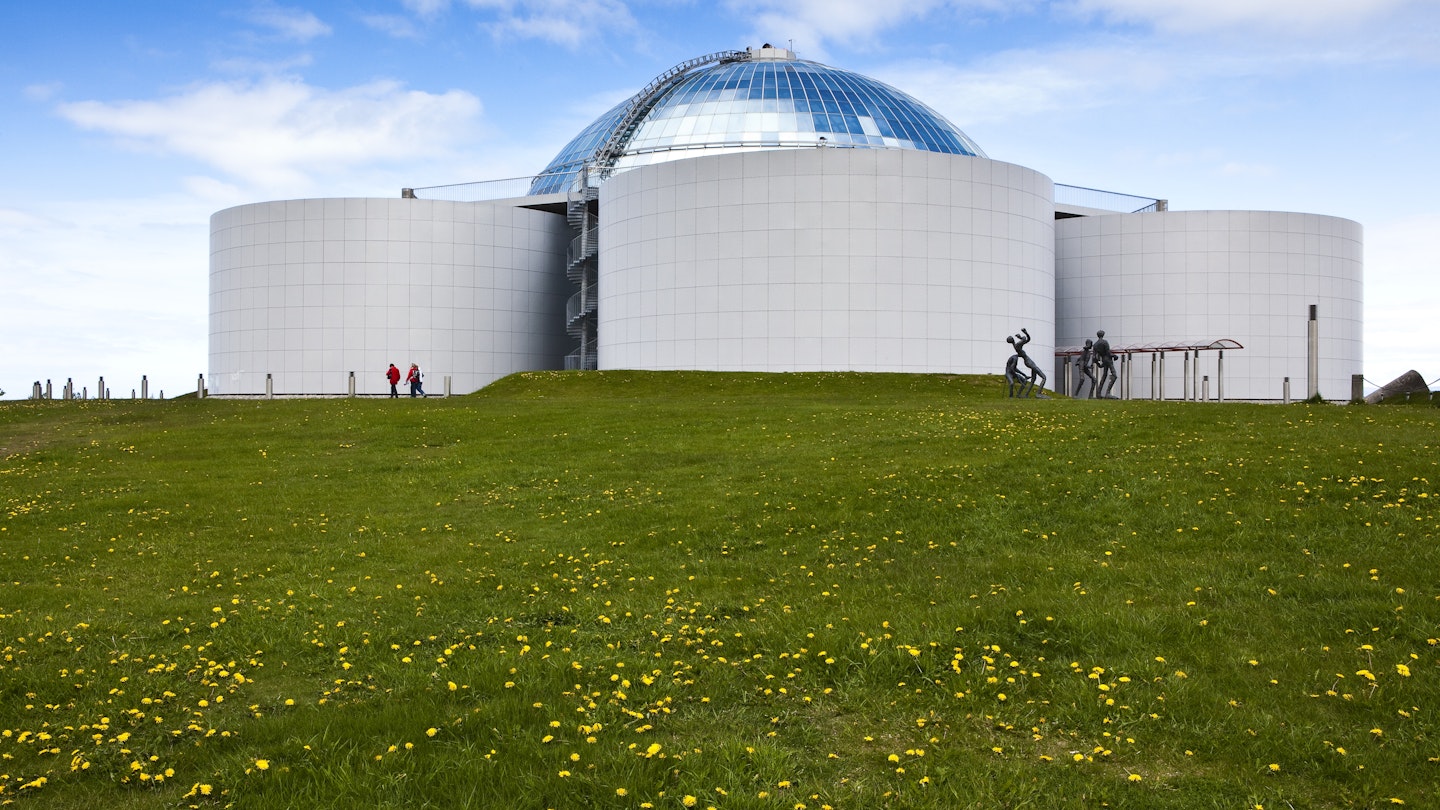Discover Reykjavik’s Fascinating Museums
From Viking history to the world’s first indoor ice cave, Reykjavik’s museums are sure to satisfy curious souls, entertain people of all ages and cater to art lovers of all kinds. Make sure to explore street art and outdoor sculptures – one of which doubles as a footbath with a view – and make the most of discount cards, such as the Reykjavik City Card (note that many museums have free admission for children and discounts for students and senior citizens). If you’re visiting in early June 2022, don’t miss the biennial Reykjavik Arts Festival.
Perlan: Best for Nature Exhibitions
Perlan, the glass dome overlooking the city from forested Öskjuhlíð, has traditionally attracted visitors with its panoramic view and the rotating restaurant on the top floor. Now they’ve added an additional attraction – Iceland’s only Nature Exploratorium.
The “Wonders of Iceland” exhibition explains the science behind the country’s natural phenomena as you explore them with all your senses. The highlight is surely the 328ft- (100m-) long authentic “Ice Cave” made with 350 tons of snow, the first of its kind in the world. You can also learn all about Iceland’s fiery volcanoes, melting glaciers, diverse plant and animal life – and don’t forget the awe-inspiring northern lights planetarium show.
Feeling adventurous? Complete your visit with a thrill on the zipline from the viewing platform (open in summer).
Árbær Open Air Museum: Best for Living History
Ever wondered what Reykjavik looked like at its infancy in the late 18th century? Find the answer at Árbær Open Air Museum – one of the five Reykjavik City Museums.
Árbær itself is an old turf farm and church that has stood in that location for centuries. Around the middle of the last century, as Reykjavik developed, traditional houses were moved from downtown to Árbær where they have since been preserved with their original interiors and furniture, serving as a kind of time warp for curious visitors. Staff are dressed in period clothing and host demonstrations like traditional haymaking and folk dances.
Whales of Iceland: Best for Whales
Unsurprisingly, this museum is all about whales. Twenty-three life-sized models of all whale species found in the waters around Iceland are suspended from the ceiling, creating the illusion of being underwater in close encounter with these giants of the deep. For an even more immersive experience, try the VR headset. Learn all about these fascinating creatures via an interactive display, and listen to their mesmerizing sounds.
This museum is best enjoyed in combination with a whale watching tour.
The House of Collections: Best for Icelandic Art History
The stately white building on Hverfisgata, near the center of town, was built in 1909 as the first purposefully built museum in Iceland to facilitate the National Library, National Archives, and National Museum. Now known as the House of Collections, it’s part of the National Gallery, exhibiting key works and shedding light on Icelandic art history.
Also visit the National Gallery and the Home of an Artist, painter Ásgrímur Jónsson’s house, on the same ticket.
Saga Museum: Best for Vikings
Do you want to face a blood-thirsty Viking warrior? Visit the incredibly life-like wax figures at the Saga Museum that represent important characters from different periods of Icelandic history. An audio guide will lead you through the various scenes, from the original settlers – Irish monks – to the reformation. Most of the scenes represent the Commonwealth Era, characters, and events described in the sagas, including the Battle at Örlygsstaðir from Sturlunga saga and Freydís Eiríksdóttir standoff from Eiríks saga rauða.
Afterwards, have your picture taken in Viking gear while swinging a sword. By then you’ve probably worked up an appetite, so consider checking out the adjacent restaurant Matur og drykkur.
Ásmundarsafn: Best for Sculptures
In beautiful Laugardalur valley stands a futuristic white dome surrounded by trees and massive sculptures. This is sculptor Ásmundur Sveinsson’s (1893-1982) former home and studio, now part of Reykjavík Art Museum. Exploring the sculpture garden with children is great fun, as they are permitted to climb the statues.
Discover the work of this pioneer of Icelandic sculpture, whose abstract art – inspired by daily life, folklore, and sagas – faced some criticism at first but is now embraced by all. A famous example is “The Water Carrier” (1937), which for decades was not deemed beautiful enough to be placed in the city center and was finally moved to the location it was designed for, the corner of Lækjargata and Bankastræti, in 2011.
Purchase a ticket that also grants access to Kjarvalsstaðir and Hafnarhús.
Reykjavík Maritime Museum: Best for Fishing History
Iceland is primarily a fishing nation. The Reykjavík Maritime Museum – one of the five Reykjavik City Museums – is located in the hip Grandi district and traces the capital’s 150 years of fisheries history, providing insight into the nation’s often dramatic relationship with the sea. Be sure to board cruise guard vessel Öðinn and learn about the Cod Wars.
If you’re visiting in early June 2022, take part in the Fishermen’s Day celebrations on June 3–5.





